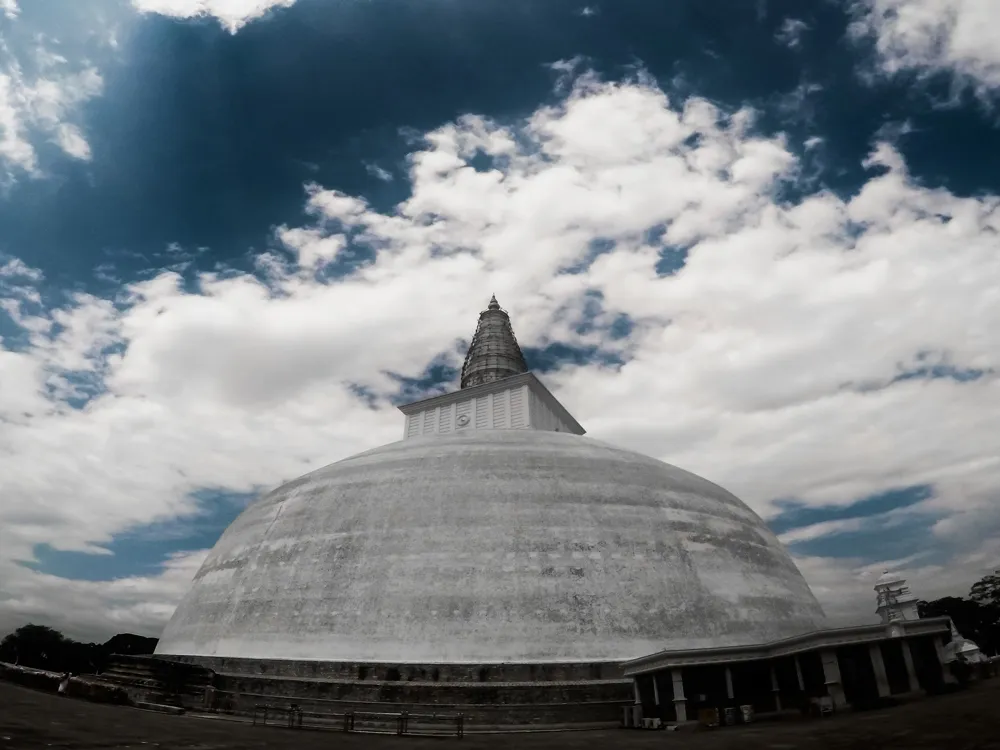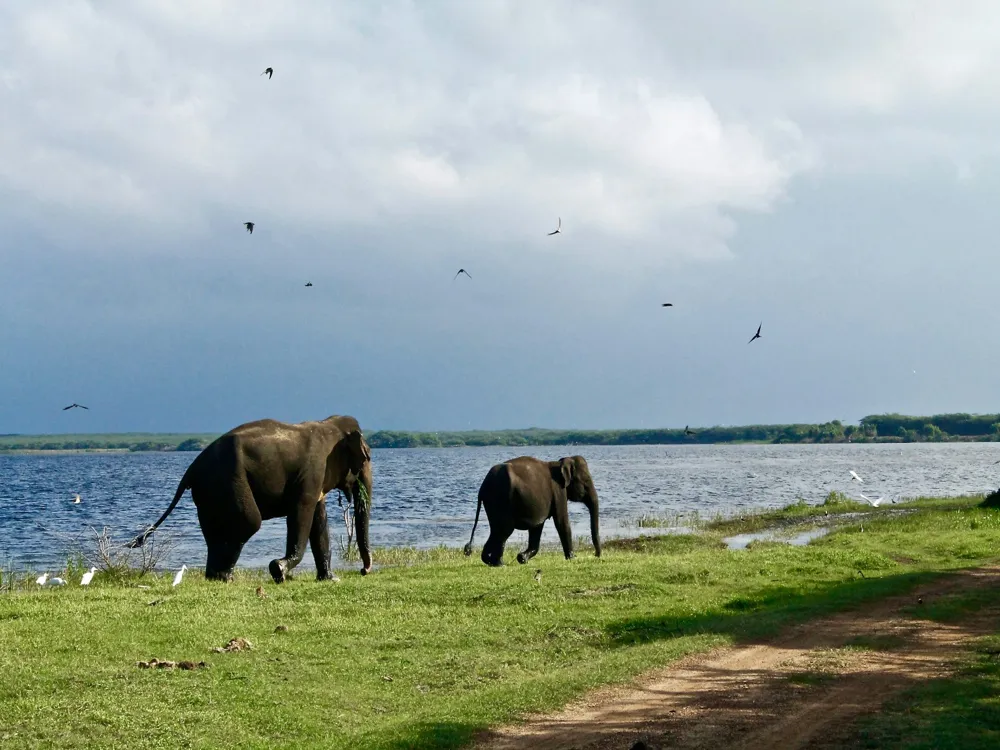Nestled in the serene landscapes of Arugam Bay, the Kudumbigala Monastery stands as a testament to ancient Sri Lankan heritage. This secluded monastery, dating back to the 2nd century BC, is a hidden gem that offers a unique glimpse into the country's rich Buddhist history. The complex is renowned for its tranquil ambiance, surrounded by lush forests and rugged terrain, making it a perfect retreat for those seeking peace and spiritual rejuvenation. The monastery's origins are rooted in the reign of King Devanampiyatissa, a period marked by the flourishing of Buddhism in Sri Lanka. Over the centuries, Kudumbigala evolved into a significant monastic complex, housing hundreds of monks who dedicated their lives to meditation and spiritual practices. The site is dotted with numerous caves, each bearing inscriptions and carvings that tell tales of the monks who once resided there. The presence of these ancient relics makes Kudumbigala not only a spiritual center but also an archaeological treasure. Visitors to Kudumbigala are immediately struck by the sense of timelessness that pervades the area. The quiet rustling of leaves, the distant calls of exotic birds, and the gentle winds create an atmosphere of profound tranquility. This peaceful environment, combined with the historical significance of the monastery, offers a unique experience that is both educational and spiritually uplifting. Whether you're a history enthusiast, a spiritual seeker, or simply a lover of nature, Kudumbigala Monastery is a destination that should not be missed. The architecture of Kudumbigala Monastery is a fascinating blend of natural and man-made elements, seamlessly integrated into the surrounding landscape. The most striking feature of the monastery is its cave complex, which is carved into the rocky outcrops of the area. These caves vary in size and layout, but each offers a glimpse into the ascetic lifestyle of the monks who inhabited them. The cave temples are adorned with intricate frescoes and sculptures that reflect the artistic styles of different periods. The use of natural rock as the primary building material gives these structures an organic feel, as if they have grown out of the earth itself. The alignment of the caves, some facing the rising sun and others overlooking vast stretches of the forest, suggests a deep understanding of the environment and a desire to live in harmony with nature. In addition to the cave temples, the monastery features several stupas, which are dome-shaped structures typically containing relics. These stupas are strategically placed throughout the complex, often at elevated locations, providing breathtaking views of the surrounding landscape. The design of these stupas, with their bell-shaped domes and intricate carvings, is a testament to the skilled craftsmanship of the ancient builders. Kudumbigala is a place of religious significance, so visitors should dress modestly and behave respectfully. Avoid loud conversations and ensure your mobile phones are on silent mode. The region can be quite hot and humid. Bring adequate water, wear sunscreen, and dress in light, breathable clothing to stay comfortable. The monastery is surrounded by rich biodiversity. While exploring, stay on marked paths and be cautious of the wildlife, which includes monkeys, birds, and possibly reptiles. Reaching Kudumbigala Monastery involves a journey through some of Sri Lanka's most scenic landscapes. The monastery is located near Arugam Bay, a popular surfing destination on the island's east coast. The nearest major town is Pottuvil, which is well-connected by road to major cities like Colombo and Kandy. From Pottuvil, visitors can hire a taxi or a tuk-tuk for the final stretch of the journey to Kudumbigala. The road to the monastery is a bit rugged, so it's advisable to arrange a vehicle that can handle rough terrain. The journey offers a chance to witness the stunning natural beauty of Sri Lanka's eastern province, with its lush greenery, rolling hills, and vibrant wildlife. Read More:Overview of Kudumbigala Monastery, Arugam Bay
Architecture of Kudumbigala Monastery
Tips When Visiting Kudumbigala Monastery
Respect the Sacred Nature of the Site
Prepare for the Climate
Be Mindful of Wildlife
How To Reach Kudumbigala Monastery
Kudumbigala Monastery
Arugam Bay
₹ 18,572 onwards
View arugam-bay Packages
Arugam-bay Travel Packages
View All Packages For Arugam-bay
Top Hotel Collections for Arugam-bay

Private Pool

Luxury Hotels

5-Star Hotels

Pet Friendly
Top Hotels Near Arugam-bay
Other Top Ranking Places In Arugam-bay
View All Places To Visit In arugam-bay
Faq on Arugam-bay
What is Kudumbigala Monastery Arugam Bay?
Kudumbigala Monastery Arugam Bay is an ancient Buddhist monastery located near Arugam Bay in Sri Lanka. It is a significant historical and archaeological site known for its religious importance and scenic beauty.
How old is Kudumbigala Monastery Arugam Bay?
The exact age of Kudumbigala Monastery is not precisely known, but it dates back to ancient times, possibly as far as the 3rd century BCE. It has a rich history spanning over centuries.
What is the significance of Kudumbigala Monastery Arugam Bay?
Kudumbigala Monastery holds great religious significance for Buddhists in Sri Lanka. It served as a place of meditation and religious practice for monks throughout history. The site is also important for its archaeological and cultural value.
How can I get to Kudumbigala Monastery Arugam Bay?
Kudumbigala Monastery can be reached by road from Arugam Bay. It's approximately a 1-hour drive from Arugam Bay town. Visitors can hire a vehicle or take a guided tour to reach the monastery.
Are there any entrance fees for Kudumbigala Monastery Arugam Bay?
Yes, there might be a nominal entrance fee for visitors to enter Kudumbigala Monastery. The fee helps with the maintenance and preservation of the site.
View arugam-bay Packages
Arugam-bay Travel Packages
View All Packages For Arugam-bay
Top Hotel Collections for Arugam-bay

Private Pool

Luxury Hotels

5-Star Hotels

Pet Friendly
Top Hotels Near Arugam-bay
Other Top Ranking Places In Arugam-bay
Faq on Arugam-bay
What is Kudumbigala Monastery Arugam Bay?
Kudumbigala Monastery Arugam Bay is an ancient Buddhist monastery located near Arugam Bay in Sri Lanka. It is a significant historical and archaeological site known for its religious importance and scenic beauty.
How old is Kudumbigala Monastery Arugam Bay?
The exact age of Kudumbigala Monastery is not precisely known, but it dates back to ancient times, possibly as far as the 3rd century BCE. It has a rich history spanning over centuries.
What is the significance of Kudumbigala Monastery Arugam Bay?
Kudumbigala Monastery holds great religious significance for Buddhists in Sri Lanka. It served as a place of meditation and religious practice for monks throughout history. The site is also important for its archaeological and cultural value.
How can I get to Kudumbigala Monastery Arugam Bay?
Kudumbigala Monastery can be reached by road from Arugam Bay. It's approximately a 1-hour drive from Arugam Bay town. Visitors can hire a vehicle or take a guided tour to reach the monastery.
Are there any entrance fees for Kudumbigala Monastery Arugam Bay?
Yes, there might be a nominal entrance fee for visitors to enter Kudumbigala Monastery. The fee helps with the maintenance and preservation of the site.



















